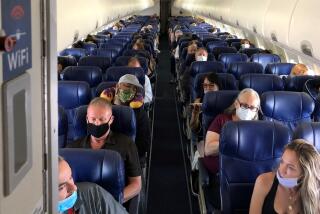Make sure germs don’t hitch a ride on you during plane travel

- Share via
Germs are everywhere, including horrifying amounts on your cellphone and tablet, according to a study by Which?, a British consumer organization. How horrifying? Electronics are dirtier than toilet seats, its 2013 analysis said.
Airplanes practically invite germs along for the ride, so when you’re packing, besides your lucky rabbit’s foot, throw in some hand sanitizer and antibacterial wipes, medical experts told me. And don’t forget your common sense and courtesy. You are entering a war zone, although the battleground may not be where you think it is.
You can blame those sneezers and coughers on a plane for airborne germs and droplets, but disease also can be spread by touch, which may be the more likely way you pick up something evil, said Angela Vassallo, the director of infection prevention/epidemiology at Providence Saint John’s Health Center in Santa Monica.
Many airplane surfaces provide a welcome home for germs, especially armrests, seat pockets and tray tables, according to a study released last year by Auburn University in Alabama.
James Barbaree, a professor of microbiology at Auburn who led the study, singles out tray tables for extra stars on the ick scale, especially when babies get changed on them, he noted.
Also big culprits in the unclean department: restrooms. Make sure you wash your hands, Vassallo said, and when you open the door after you’ve dried your hands, use a paper towel to do so. Then apply hand sanitizer as an extra precaution, she suggests.
If you decide to wipe down your area, bleach or hydrogen peroxide is best, she said. You’re not going to carry Clorox on board, but hydrogen peroxide wipes are easy to put in a plastic bag and carry.
Masks can be worn both as a deterrent or as a preventive measure (although in my experience, they raise the discomfort level in an already uncomfortable situation).
But wait. Aren’t we getting a little too phobic? Maybe. Maybe not. The Auburn study noted that MRSA could live as long as a week in an airplane; the R stands for resistant, as in resistant to antibiotics. It can be life-threatening. If you’re susceptible to infection, perhaps because of a weakened immune system, being too cautious can’t hurt and it could help.
Given a choice between washing my hands and using hand sanitizer and being hijacked by a bacterium, I say bring on the water and gel.
And, said Dr. Nikhil Bhayani, an infectious disease specialist on the medical staff of Texas Health Arlington Memorial, bring on the good manners too.
Yes, common courtesy can play a role in preventing the spread of disease. He recently was seated next to a woman who was ill and kept her used tissues on the armrest. (Stuffing them into the seat pocket isn’t very nice either. Better idea: You know that 1-quart bag in which you carry your liquids through airport security? Stuff your used tissues in there until you can dispose of them.) After the flight, he came down with a bug as well.
Again, no one can be certain where the original bug came from, but that doesn’t mean you shouldn’t be considerate of those around you. “Do you really need to populate the area with your used tissues?” Bhayani asked, rhetorically.
One day, none of this may be an issue. Michael Ruley is chief executive of Dallas-based Allied BioScience, which is developing an antimicrobial product called SurfaceWise. It goes on as a liquid and forms an invisible barrier; it could last as long as three months between applications, he said.
The company has been working with a hospital and with public transit to test its product and thinks it has also applications for the cruise industry, which has grappled with the digestive pest norovirus, and for airlines.
Although ship and plane passengers could benefit, the financial incentive for airlines to become proactive is less urgent. You’re not as captive on an airline as on a cruise ship, and there’s no real way to prove that nasty bug that’s making your nose run and your head pound came from a seat pocket or a seatmate.
Until then, soap, water, hand gel, wipes, and common sense and courtesy are nothing to sneeze at.
Have a travel dilemma? Write to travel@latimes.com. We regret we cannot answer every inquiry.
More to Read
Sign up for The Wild
We’ll help you find the best places to hike, bike and run, as well as the perfect silent spots for meditation and yoga.
You may occasionally receive promotional content from the Los Angeles Times.







